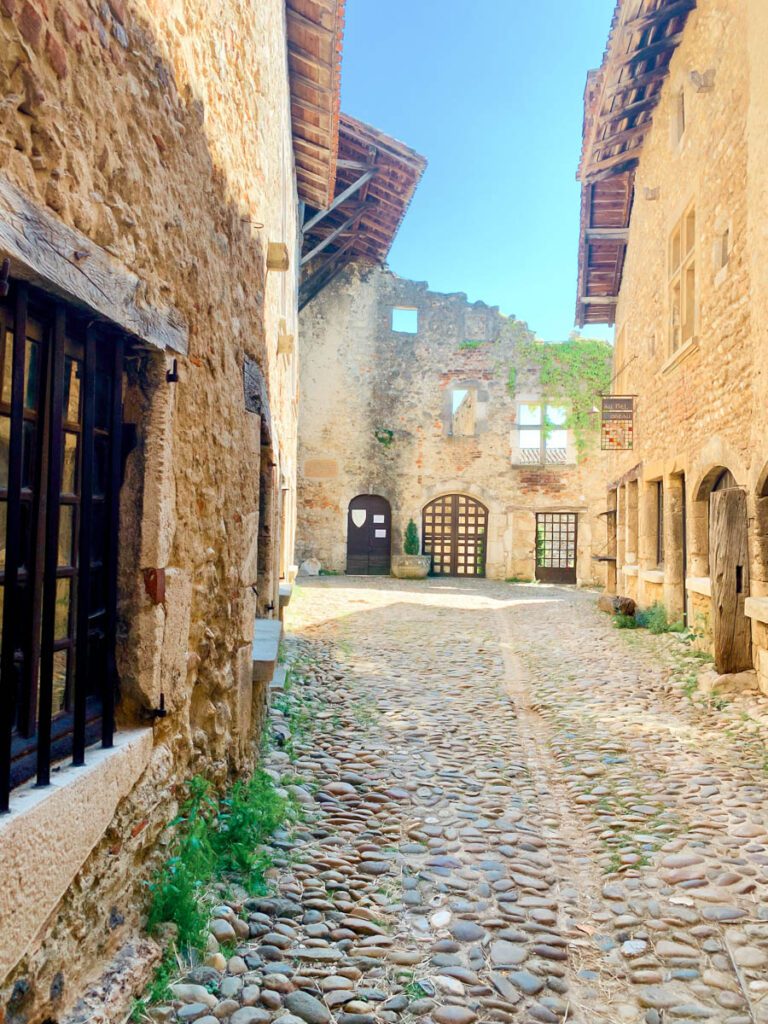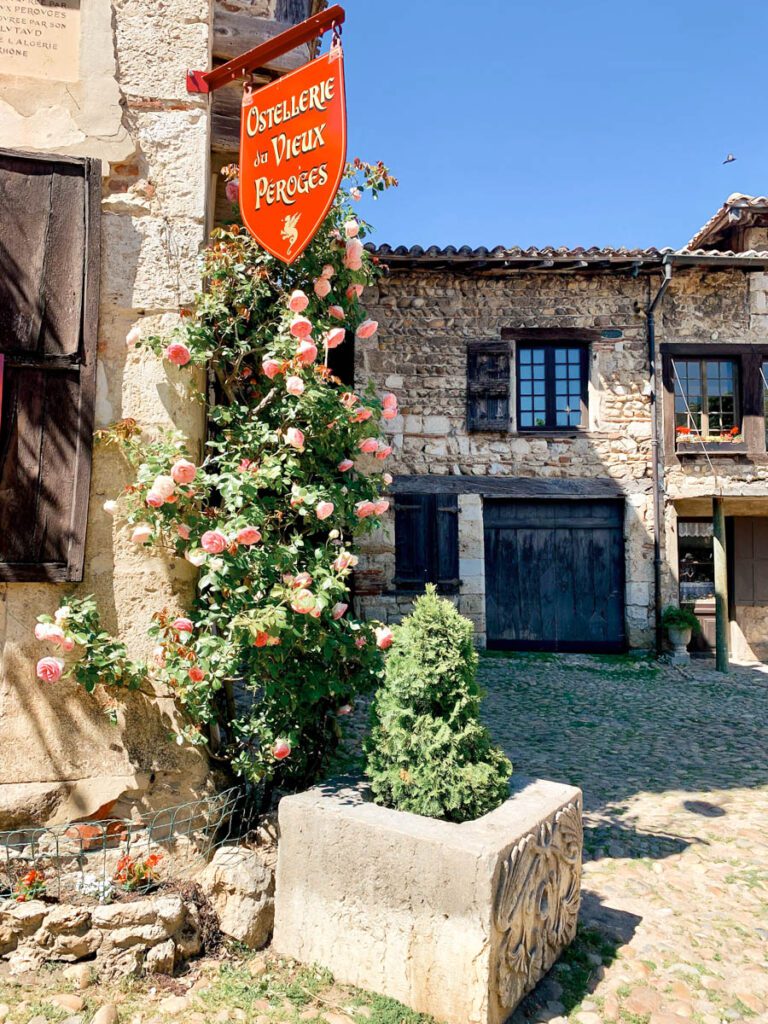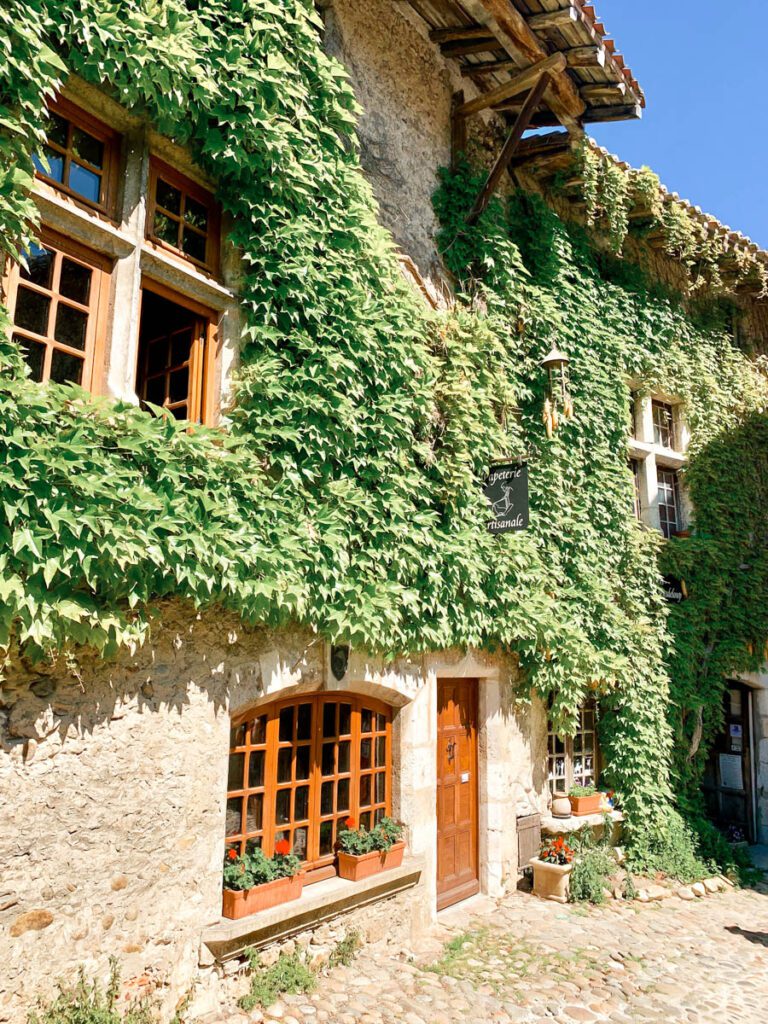Located in France’s Rhone-Alps region, medieval Perouges, France (pronounced pay-roojh) is perfect for a day trip. Just 25 miles north of Lyon, you can get there in about 30 minutes by car or train. You can also get there from Geneva, Switzerland in about 90 minutes by car or under two hours by train.
This fascinating medieval village sits perched atop a hill, overlooking the plain of the River Ain, completely surrounded by a stone wall. As you enter the gate you will feel as though you’ve stepped back in time. To call Perouges picturesque is an understatement. I would definitely describe it as “instagrammable”, as there always seemed to be another photo opportunity around every corner. Imagine it…..half-timbered houses, cobblestone streets, geraniums on every windowsill….there is a reason many movies have been filmed here, including Les Trois Mousquetaires (The Three Musketeers) in 1961.

The French government declared Perouges to be one of the most beautiful villages in France (Les Plus Beaux Villages de France). It’s also one of the most well-preserved. The village is thought to have been founded in the early 1100s by a Gallic colony returning from Perugia, Italy. It was mainly inhabited by winemakers, linen weavers, farmers, and craftsmen in the late 14th and 15th centuries. Perouges officially became part of France in 1601. There were 1,500 residents by the 18th century when its textile industry was booming, but the population plummeted to just 90 residents by the 19th century when railroads and roads were re-routed and bypassed the town. The government preserved and restored the town after it faced demolition in 1909.
The main entrance takes you through an ancient stone gate known as La Porte d’en Haut. Here you will see the towers, which are part of the ramparts. The town built these towers in the 13th century and the French government now considers them to be a historical monument. To the left you will then pass the Catholic Fortress Church, also a historical monument built in the 15th century.
In the heart of the town, you can check out the Musee du Vieux Perouges (Museum of Old Perouges) for a fee of five euros. Here visitors can view a collection of ancient artifacts from everyday life in Perouges, as well as gain access to a medieval garden, a weaving workshop, and the watchtower with its panoramic views. The museum also houses a collection of fine contemporary art, as well as an archeological collection from local excavations. And if you’re interested in the Merovingian dynasty, the museum even includes a Merovingian burial tomb.
The galets (streets) in the village are paved with aged stones that were collected from nearby rivers. I do recommend comfortable, sturdy shoes for exploring the town as these beautiful cobblestones are also quite uneven in many places.

The main square is still the site of a linden tree planted in 1792 during the French Revolution; thus, the square is known as La Place du Tilleul (the liberty tree). Here you will find one of the oldest inns in France, the Hostellerie du Vieux Perouges, where they offer accommodations and serve regional dishes in the restaurant.
“To call Perouges picturesque is an understatement. I would definitely describe it as Instagrammable.”
The culinary dish you should not miss here is Galette de Perouges, a recipe created in 1912 by a local woman. It’s made from brioche dough with yeast that has been flattened and baked with butter and sugar on top, on a wooden paddle in a hot oven until the top caramelizes. It looks like a pizza, but it’s like an explosion of textures in your mouth – it somehow manages to be chewy, soft, and crispy all at the same time. Kings, queens, and presidents (including Bill Clinton during the G7 Summit in Lyon in 1996) have visited Perouges and tried this famous local dish. Perougeoise is another staple dish here, made of grated potatoes, mustard cream, and Bleu de Bresse cheese, and served with a roasted chicken on top.

There are currently 1,180 local inhabitants in the town, which is what I think helps maintain the town’s authenticity, despite its reputation as a spot for tourists. What you will (thankfully) find missing from Perouges are the tacky souvenir shops you would typically find in a popular day trip spot like this. Instead, you will find the likes of a bakery, apothecary shop, several wineries, craft shops, restaurants, a chocolaterie, etc.
I took time to explore many of the shops throughout the town and my favorite was Papeterie Artisanale de Perouges, a handmade paper workshop. Here you will find an open space where you can watch how the pulp is prepared with machines from flax, cotton, and hemp fibers. They then form the paper by hand, sheet by sheet, using a traditional mold. I purchased a lovely bookmark with a hand painted scene of Perouges on the front and it’s still one of my favorite items I’ve picked up during my travels!
The best time to visit Perouges is April to October. However, they close most of the shops on Wednesdays in April. Perouges also has a Christmas market in December. On the day I visited in late May, I found the weather to be perfect with pleasant, slightly warm temperatures and clear blue skies. You can find the official website here.

If you want to try to avoid the bus tours (like mine!), you should aim to go early in the day, but not too early if you want to visit the shops as they will still be closed. However, even with the bus tours there, I didn’t find the small village to be what I would consider crowded. In fact, when I ventured away from the main square, I was able to find spots where there was nobody else around and I was free to take lots of photos of the architecture without any other visitors in the background.
If arriving by train, it’s a 20-minute walk from the train station to the town. If arriving by car, there is a convenient visitor parking lot outside the town’s gate where you can park for a couple of euros. From the parking lot, it’s a short but uphill walk to get to the town entrance where access is free. On your way in, you might want to pop in the tourist office just outside the entrance for some information on Perouges.
You can easily explore the town in a couple of hours, or a half day if you really want to take in the atmosphere and explore further away from the main square. Take a stroll around the winding streets, take lots of photos, then settle down in one of the restaurants for lunch. If you enjoy a quiet evening, you could also choose to spend a night here in one of the available lodging options. Whether you choose to overnight here or just spend a few hours exploring, this beautiful and historic town truly is a hidden gem not to be missed in France!
Did you enjoy this article? Then go to my website here and sign up for the Life List Travel Tribe newsletter for more travel inspiration and tips!
Leave a Reply